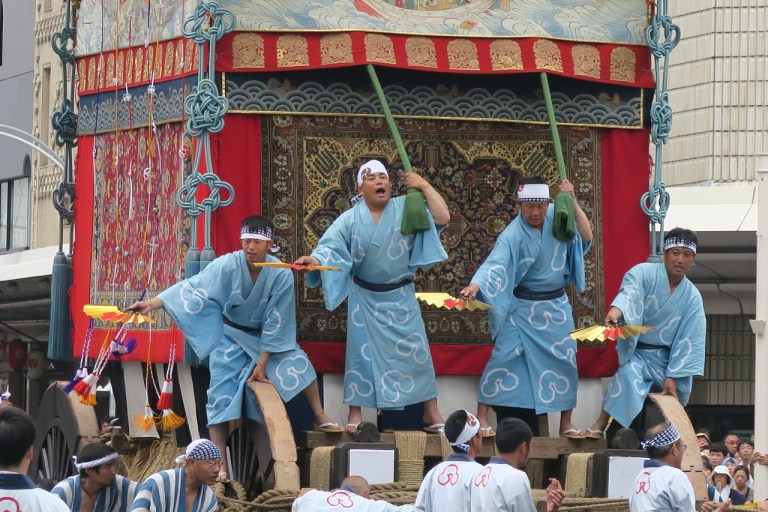We were able to experience two aspects of Kyoto’s Gion Matsuri: the evening strolls occurring on July 14, 15, and 16 and the morning parade on July 17. Following are our experiences and opinions regarding both.
Evening Strolls on July 14, 15, and 16
On these evenings, the different Gion Matsuri floats are stationed on streets around the intersection of Shijo and Karasuma. If you search, you should be able to find a map of the actual float locations.
Between dusk and 11pm, the streets are active with pedestrians (and mostly, if not completely, blocked from cars).

Most of the floats – especially the larger ones – will be active with performances. We walked around for a while and were able to see about 8 different floats in action.

Some of the floats offer opportunities to pay to visit. We didn’t visit any floats, but we saw signs at some float offering visits for a fee. One posted fee we saw was 700 yen / person.

There are many tourists out visiting the floats, but there also seem to be many locals. It will be easy to see young men and women walking around in yukatas (summer kimonos). The atmosphere is festive, and the crowds were generally not too large to cause pushing and crowding.

We found the floats to be especially beautiful at night with lanterns hanging from them. All of the floats seemed to have lanterns, but these lanterns were not present in the parade on July 17.

We tried some of the available street food, but we felt that it was expensive for the quality and portions. We had yakisoba (a noodle dish) with meat, okonomiyaki (Japanese pancake), and takoyaki (fried meat balls).


There were recycling booths set up near the food stands. These booths were manned with student volunteers who were happy to help you determine which bin to use.

Evening Stroll Recommendations:
- Reference a map with the float locations. This will allow you to see as many floats as possible (if you like). Note that some streets will be one way for pedestrians.
- Eat a small dinner before going to see the floats. This will allow you to buy only the street food you really want to eat.
- Grab some drinks from a convenience store while walking to see the floats. The drinks for sale around the floats will certainly be more expensive.
Parade on July 17
We arrived at our desired parade-watching location about 90 minutes before the parade was scheduled to reach that corner, and already found the corner to be crowded. We ended up being three rows back. We stationed ourselves on the southeast corner of Shijo and Kawabara, which was nicely shaded for most of the parade and provided a good view of the approaching floats.

Corners are recommended positions along to parade route because watching the floats navigate the first turn on the course is interesting. The smaller floats are just lifted by 12-25 men, but the larger floats must be turned incrementally by rolling the float onto wet bamboo planks and then pulling hard. It’s certainly a fun process to watch. Many of the floats also have dances or other ceremonies along the route.




Parade Recommendations:
- Watch from a corner! The southeast corner of Shijo and Kawabara is shaded. If you want to be in the front, you’d likely need to arrive 2.5 hours early. Being three rows back (after arriving 90 minutes before on a cloudy Monday July 17) provided decent views, but it was difficult to see the bamboo slats being placed.
- Do not rely on movable barriers in the road remaining where they are. The barrier on the eastern side of Shijo street was pushed farther away from the intersection about 30 minutes before the parade reached that point, moving many observers much farther away.
- Bring plenty of water, sports drinks, and food. Do not plan on leaving your spot for more food or bathrooms, as your spot will likely not remain when you return.
- You may have to stand your ground. Some observers will try to push you so they can get a better view.
- Consider arriving about an hour or 90 minutes after the parade has begun – some people will leave and you may get a decent view or consider watching from a straight part of the course if you don’t want to arrive early. The floats are worth seeing a few of regardless of how long you want to spend.
- Try to secure lodging within walking distance, as it could be difficult to get a taxi/bus/metro to/from the parade route. We stayed at K’s House Kyoto.






Take-away
We enjoyed watching the floats navigate the first corner of the parade route on July 17. The crowds were large and tiring, but also generally well-controlled. However, we enjoyed seeing the floats up close on the preceding three evenings more – the lanterns were beautiful, the temperature was cooler, and the crowds were smaller. In the end, we’d recommend doing both!
Between ample police for the parade, recycling stations for the evening strolls, and at least one huge ‘hyper-ambulance’ ready for action – Kyoto is certainly prepared for the crowds that attend Gion Matsuri.


3 thoughts on “Kyoto’s Gion Matsuri”